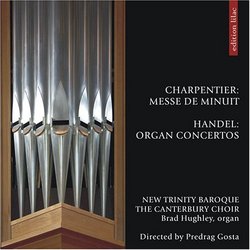Album DescriptionMarc-Antoine Charpentier composed his 'Messe de Minuit' around 1694 for a Christmas Midnight Mass celebration at the Jesuit Church of St. Louis in Paris, where he held a post of maître de musique. He adapted eleven French noëls to fit the sacred text of the Messe, following the custom of singing folk-song-like Christmas carols during the celebration of the Midnight Mass in France, which dates from the 16th century. The use of Noëls in French music was also a regular practice in the organ repertoire. Charpentier has already composed instrumental carols, pastorales and oratorios on Christmas themes, but the idea of basing the whole Mass on French carols was something new. The use of music of profane origin (such as Christmas carols) with sacred texts puts 'Messe de Minuit' in the genre of the parody mass. Charpentier also composed new material which he combined with the folk-song-like carols (e.g. 'Et in terra pax' in 'Gloria', and 'Et incarnatus est' in 'Credo'). Vocal-instrumental parts often alternate with solo organ pieces (e.g. in 'Kyrie'). The noëls for organ, which are performed between the Kyrie movements, were composed by André Raison who was the organist at the Church of St. Louis at the time when Charpentier held the post of music director. Charpentier also notes in the score that instrumental music should be performed during the Offertory. He suggests which music to use, but he leaves to the performer the final choice. François Couperin?s 'Offertoire sur les grands jeux', which takes a prominent place in his 1690?s Mass for the Parishes, is an ideal choice. Handel composed his organ concertos to be performed in the intermissions of his operas. They are compiled in opp. 4 and 7, each one containing six concertos, three more published independently. 'The Cuckoo and the Nightingale' is one of the most popular, called so because of its second movement which imitates a dialogue between the cuckoo and the nightingale. The other two concertos are examples of Handel?s artistry to adapt and combine: the last movement of his Concerto in g minor is based on the movement from Georg Muffat?s Second Sonata in g minor from 'Armonico Tributo' (published in 1682). Several other movements are based on music from Handel?s other works, adapted for organ and orchestra. Predrag Gosta


 Track Listings (31) - Disc #1
Track Listings (31) - Disc #1